LisbonLisboaPortugal.com
The best independent guide to Lisbon
LisbonLisboaPortugal.com
The best independent guide to Lisbon
The Belem district of Lisbon: a tourism guide for 2026
While much of Lisbon turns inward to its labyrinthine streets, the district of Belém opens itself to the wide expanse of the Tejo estuary. This is the city’s historical gateway to the wider world, a district defined by ambition, discovery, and the immense riches that followed.
It was from these riverbanks that Vasco da Gama kept vigil before his pioneering voyage to India, and it is here that the spirit of Portugal’s Age of Discovery remains most potent, captured in limestone monuments that line the banks of the Tejo estuary.
To explore Belém is to trace the legacy of that golden era. The immense wealth of the new sea routes to India and Brazil funded the creation of the breathtaking Mosteiro dos Jerónimos, a masterpiece of uniquely Portuguese architecture. Nearby, the elegant Torre de Belém stands as a permanent symbol of the nation’s maritime power, while the Padrão dos Descobrimentos monument charts a course to the horizon, its stone figures poised for discovery.
Beyond its iconic landmarks, Belém’s appeal lies in its serene and spacious atmosphere, a striking contrast to the dense heart of the capital. With its manicured gardens, scenic riverside promenades, and calm plazas, it invites a slower, more contemplative pace. This is more than a historic neighbourhood; it is the enduring symbol of a nation that dared to discover the world.
Highlights of Belém
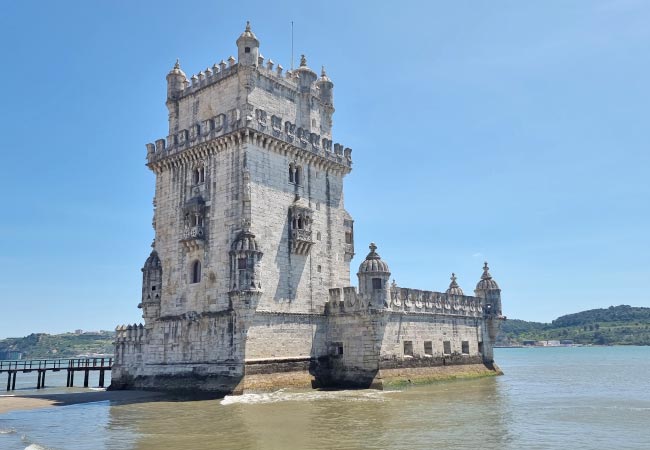
The Torre de Belém – This delightful fort once stood in the centre of the Tejo Estuary and guarded Lisbon from attack by sea. The little fort was inspired by Moorish architecture and boasts whimsically styled watchtowers, decorative stone carvings and Europe's first depiction of a rhinoceros (guide to the Torre de Belém).
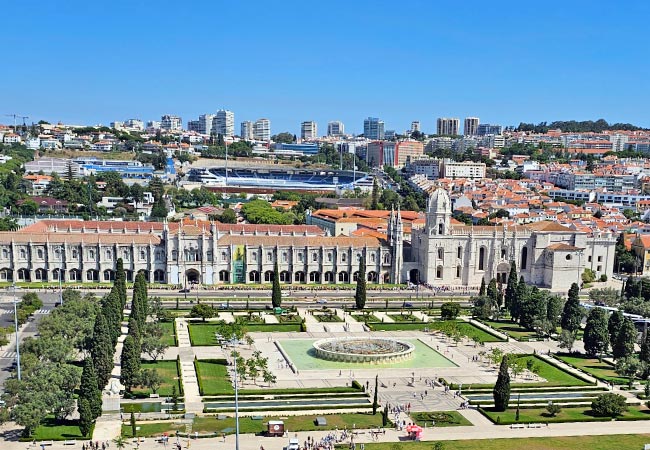
The Mosteiro dos Jeronimos – This magnificent monastery took over 100 years to complete and was funded by the wealth of the 16th-century spice trade. Found within this huge complex are Manueline styled cloisters, the beautiful Igreja Santa María de Belém church and elaborate stonework surrounding the southern doorway. (guide to the Mosteiro dos Jeronimos)
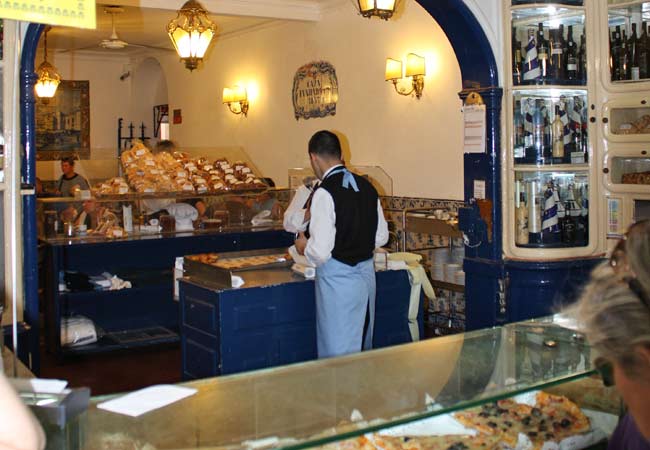
Pastéis de Belém - The traditional home of the Pastel de Belém, the original Pastel de Nata custard tart. This bustling café is the perfect place to take a break from sightseeing, and their delicious custard tarts offer a real taste of Portuguese culture.
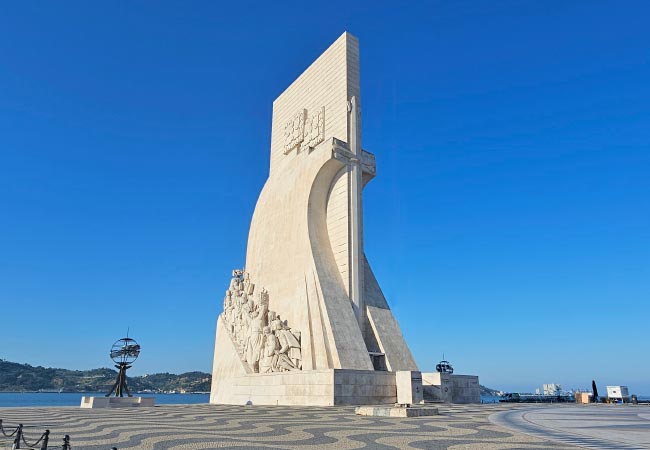
The Padrão dos Descobrimentos – This towering monument stands high above the banks of the Tejo Estuary and celebrates the seafaring history of Portugal. From a distance, it may appear as a massive concrete monstrosity, but up close there is beautiful detailing on its sculpted figures, as well as cleverly hidden symbolism. At the top of the monument is one of the best viewpoints of Lisbon (guide to the Padrão dos Descobrimentos).
A tour of Belem
Belém is regarded as one of the best tourist districts in Lisbon and is well worth a visit during your stay. Situated on the western outskirts of the city, the district is typically visited on the second day of sightseeing, after the downtown districts of Baixa and Alfama.
It takes around half a day to see all of the main sights of Belem, but a whole day can be easily spent here if you include visits to its fascinating museums or enjoy a pleasant stroll along the waterfront.
Insight: The Alcantara district and LxFactory are also to the west of Lisbon (and served by the E15 tram route), and are often visited after the Belem district.
The following map is a suggested tour of Belem, which begins from the E15 tram stop (travel details can be found later in this article). The most common tour of Belem follows stages 1 to 10, but this can be extended by visiting the eastern side of the district and taking a riverside walk to the MAAT museum viewpoint (18).
Sights of the tour: 1) Southern Doorway (Mosteiro dos Jeronimos) 2) Igreja Santa María de Belém 3) Mosteiro dos Jeronimos 4) Jardim da Praça do Império 5) Padrão dos Descobrimentos 6) Farol de Belém (Old Belem Lighthouse) 7) Torre de Belém 8) Monumento aos Combatentes do Ultramar 9) Centro Cultural de Belém 10) Pastéis de Belém 11) Palácio Nacional de Belém 12) Jardim Afonso de Albuquerque 13) Jardim Botânico Tropical
Museums: 14) Museu Nacional dos Coches 15) Museu de Marinha 16) Coleção Berardo (contemporary art gallery) 17) Central Tejo (power station museum, part of MAAT) 18) Museu de Arte, Arquitetura e Tecnologia (MAAT)
Getting the most from Belém
As one of the most popular tourist areas of Lisbon, Belem can unfortunately become very crowded during the peak season. Here are some insights on how to get the most from your day trip during the busiest months.
There will always be a long queue for the Mosteiro dos Jerónimos, but there is rarely a queue for the Igreja Santa María de Belem, the church which is attached to the monastery. Inside the church is the tomb of King Manuel I and Vasco da Gama, along with beautiful examples of Manueline stone carvings. Best of all, the church is free to visit. The entrance to the church is via the western doorway, next to the queue to enter the monastery.
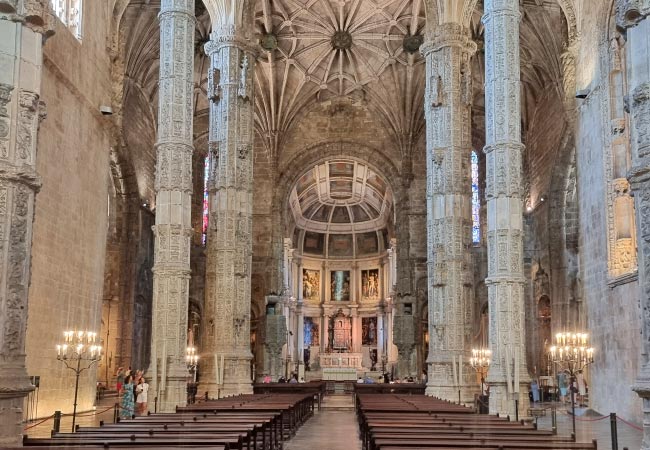
The Igreja Santa María de Belém with its beautiful carved stone pillars
The finest stone carvings of the Mosteiro dos Jerónimos surround the exterior of the southern doorway into the Igreja Santa María de Belém. These can be viewed from the outside, with no need to queue or pay an admission fee.
The Torre de Belém is another busy attraction, again with long queues to enter, but its best aspects are all on the outside. The fort is surprisingly small and the internal rooms sparsely decorated, and it’s not worth a 40-minute wait to enter.
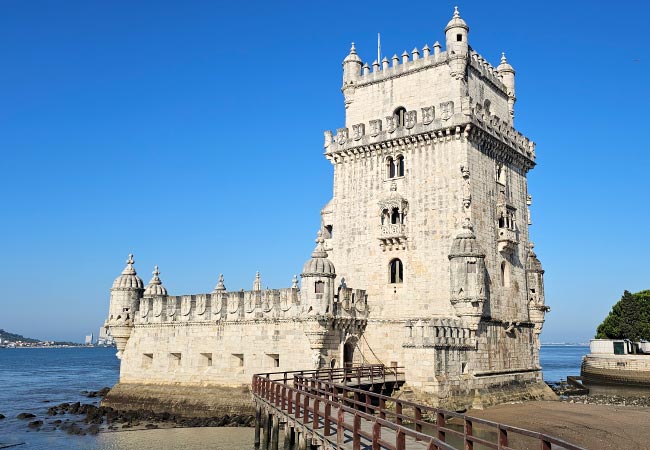
The best photo of the Torre de Belém is from the outside, and there is not much more to see by entering it.
The Fábrica Pastéis de Belém is deceptively large and has many inner rooms however, you may still have a long wait for a table. Instead of eating inside, why not buy a pack of its delicious Pastéis de Belém from the attached shop and enjoy them within the pretty gardens of the Jardim da Praça do Império.
At lunchtime, every restaurant in Belem is likely to be busy. It's better to plan an early or late lunch to avoid rushed or poor service.
The walk between the Padrão dos Descobrimentos and the Torre de Belém is incredibly scenic, but again may be very crowded. If you'd prefer a more peaceful stroll, head eastwards from the Doca de Belém and ferry terminal to the MAAT museum. There is a scenic viewpoint on the roof of the MAAT museum, which is free to climb up to.
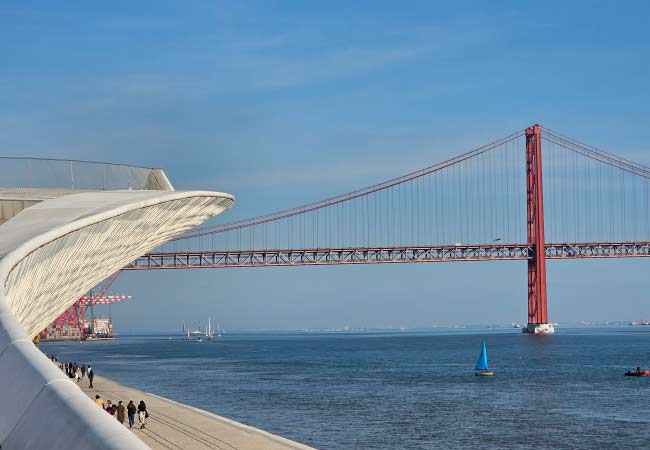
The view of the Ponte 25 de Abril bridge from the MAAT view point
Travel to Belem
Belem lies 5km to the west of central Lisbon and the Baixa district. The easiest way to travel to Belem is by taking the number 15 tram, which departs from the Praça da Figueira and passes through the Praça do Comércio. The journey takes 15 minutes and a single ticket purchased on the tram costs €3. There is also a 24-hour unlimited public transport ticket costing €7.00, but this can only be purchased from any metro station (and not on the tram). The tram stop for Belem is called ‘Belém-Jerónimos' and is next to the Jerónimos monastery.
While the E15 tram is the easiest way to travel to Belem, it does get very crowded and attracts skilled pickpockets.
Good alternatives are the 714 or 728 bus routes, which connect Belem and the Baixa districts and follow the same route as the tram. The bus is cheaper than the tram, with a single bus ticket costing €2.
Related articles: Tram E15
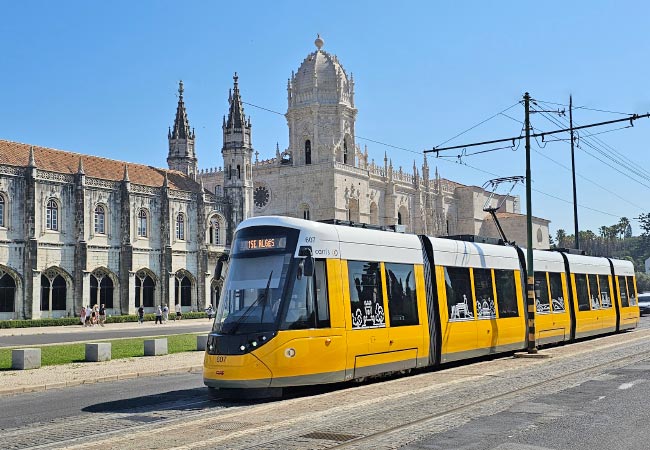
The E15 tram outside of the Mosteiro dos Jeronimos
The tourist attractions of Belem
The Mosteiro dos Jeronimos
The Mosteiro dos Jerónimos is an extravagant monastery that was funded by the 5% tax levied on spices that flowed into Portugal. Originally designed as a modest monastery, the excessive trade wealth extended the construction by 60 years, resulting in one of the most ornate religious buildings in Portugal.
The site has a close connection to the early explorers, with Vasco da Gama spending his last night here before his epic voyage to India. The church was later where sailors' wives would come to pray for the safe return of their loved ones.
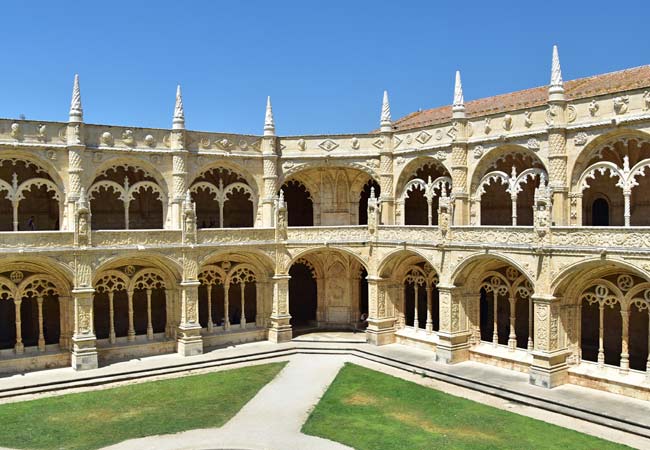
The Manueline styled cloisters
The Padrão dos Descobrimentos
The Padrão dos Descobrimentos was originally erected as a temporary monument for the World Exhibition hosted in Lisbon in 1940. It was made a permanent structure in the 1960s and commemorated 500 years since the death of Henry the Navigator (Infante Dom Henrique).
On the western side of the monument you’ll find depictions of the explorers, while on the eastern side are the key financiers, with both sides supporting the statue of Infante Dom Henrique, the driving force behind Portugal's 15th century ‘Age of Discovery’. The monument is ingeniously designed to give the appearance of the bow of a boat overlooking the estuary, with the rear representing the Latin Cross.
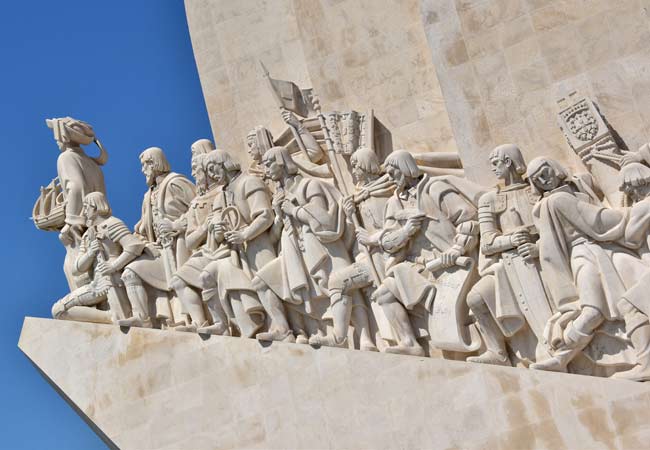
The eastern side of the Padrão dos Descobrimentos
Torre de Belém
The delightful Torre de Belém once stood in the centre of the Tejo Estuary and guarded the city against attack by sea. For such a minor defensive fortification, the Torre de Belém was built with elaborate craftsmanship and is adorned with beautifully carved stonework in the Manueline style of architecture.
Related articles: The Torre de Belém
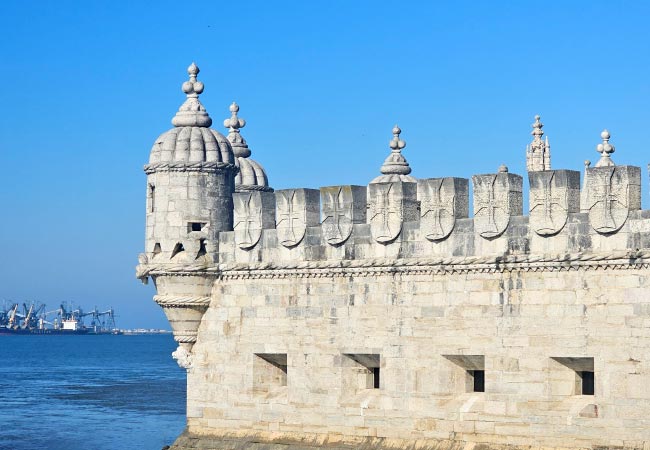
The shield-shaped battlements of the Torre de Belém
The Centro Cultural de Belem (CCB)
The Belem Cultural Centre (BCC) was constructed to host the 1992 European presidency. Today this sprawling complex contains concert halls, exhibition rooms and the Museu Coleção Berardo, Lisbon's best contemporary art gallery. museuberardo.pt
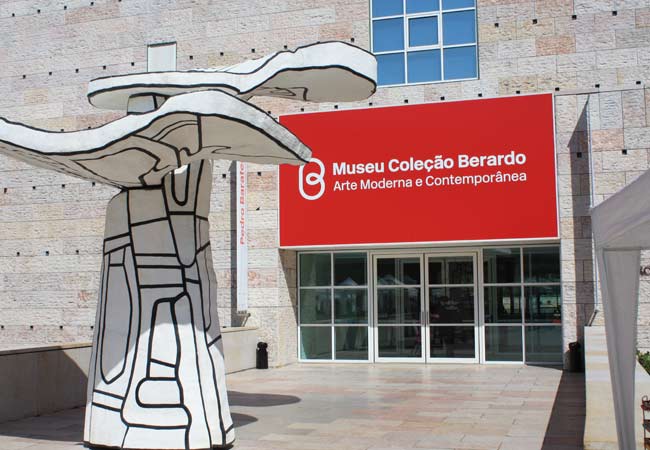
Museu Nacional dos Coches Museum
The Museu Nacional dos Coches Museum is home to a fascinating and niche collection of horse-drawn carriages. These wonderfully decorative carriages span many centuries and include vehicles used by European royalty. The museum has two buildings; the main collection being housed in a modern complex, with a secondary, smaller collection displayed in the formal royal arena.
Official website: museudoscoches.gov.pt/pt/
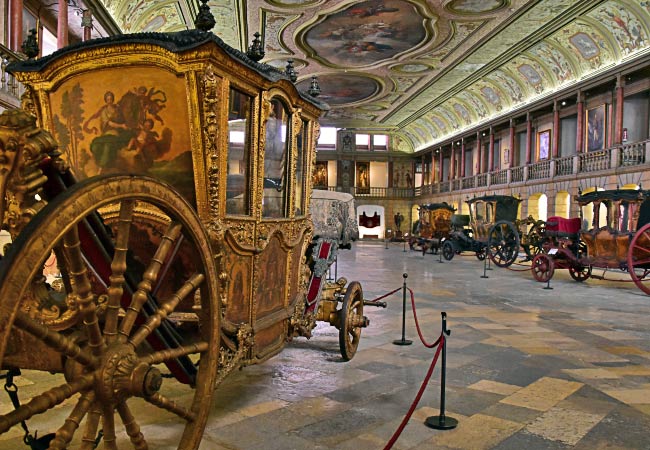
The royal riding arena and the delightful coaches
Palácio de Belém
The pink Palácio de Belém is an elegant 18th-century palace that, serves as the official residence of the President of Portugal and is renowned for its stunning architecture and significant role in Portuguese history.
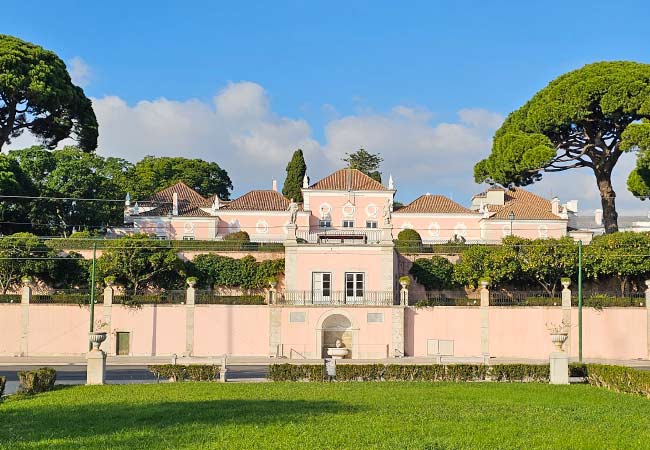
Rosa dos Ventos
In front of the Padrão dos Descobrimentos is a beautiful 50-meter wide mosaic depicting a rose compass with a central map illustrating all the countries Portugal sailed to during the 16th century. This intricate artwork, known as the Rosa dos Ventos, was installed in 1960 as a gift from South Africa in commemoration of the 500th anniversary of Henry the Navigator's death on November 13, 1460.
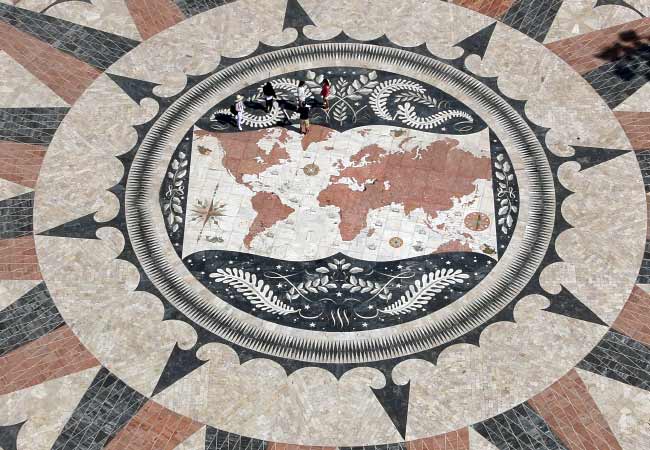
The Rosa dos Ventos as seen from the top of the Padrão dos Descobrimentos
Museu de Marinha
The Museu de Marinha details Portugal's maritime history and is housed in the western end of the Mosteiro dos Jeronimos. The museum is divided into two sections; the first contains historical artefacts and models of ships, while the second boasts impressive royal yachts and fascinating early aircraft.https://ccm.marinha.pt/pt/museu
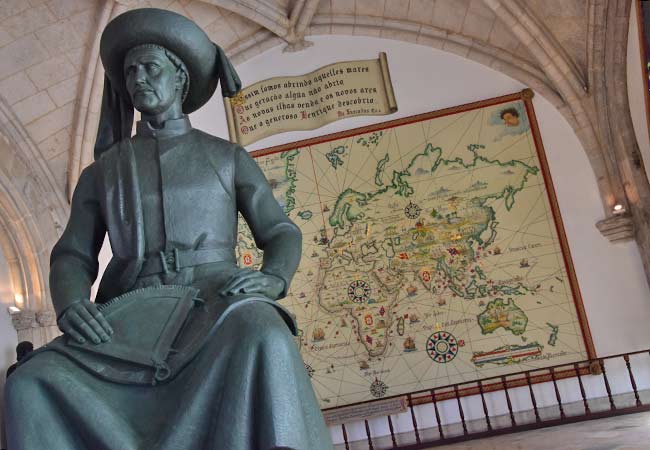
Jardim da Praça do Império
The Jardim da Praça do Império is one of Europe's largest plazas. It is filled with ornamental water gardens, with a grand fountain as its centrepiece.
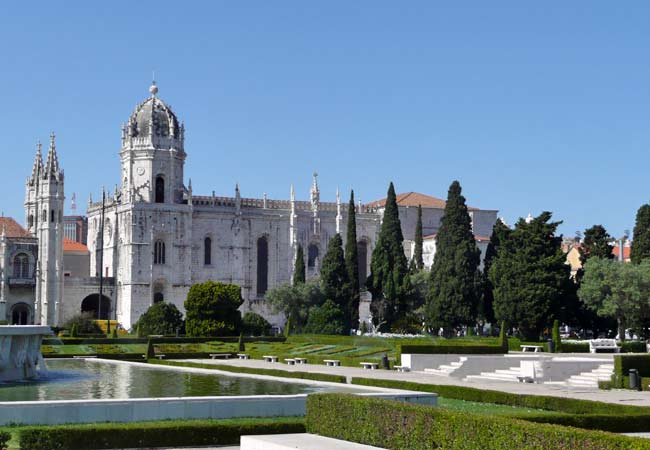
Monumento aos Combatentes do Ultramar
The Monumento aos Combatentes do Ultramar is a war memorial honouring Portuguese soldiers who died during the African independence uprisings of the 1960-1970s. The name of each soldier who died is inscribed on the walls surrounding the memorial.
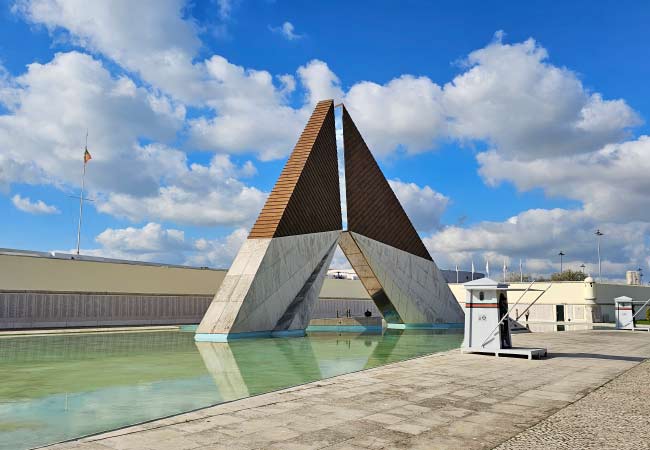
The Lusitânia Fairey seaplane monument
The Gago Coutinho Fairey-Seaplane Monument in Belém, Lisbon, honours the pioneering aviation achievements of Gago Coutinho and Sacadura Cabral, the first pilots to fly across the South Atlantic Ocean. This monument features an exact replica of their Fairey IIIB seaplane, Lusitânia, and commemorates their historic 8,400 km journey from Lisbon to Rio de Janeiro in 1922.
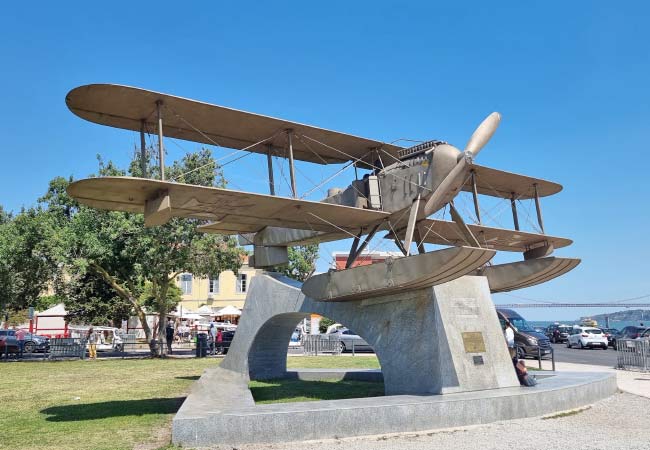
Costs for a day trip to Belem
Belem can offer an inexpensive day trip if you choose to wander the district and view the exteriors of the main sights. Entrance fees and costs are:
• 2 x €3 for the tram (2x €2 return bus fare)
• €10 - Padrão dos Descobrimentos
• €8 - Torre de Belém
• €12 - Mosteiro dos Jeronimos
• Free - Igreja Santa María de Belém
• €5 - Pastel de Belém
• €5 - Museu Coleção Berardo art gallery
Discover more of Lisbon with our most popular guides
If you've found our content valuable, we'd welcome your support.
The digital publishing landscape has evolved significantly. As a small independent publisher, we face growing challenges. Search engines increasingly favour paid content over organic results, while AI-generated content often reproduces original work without attribution.
To support our work, please consider bookmarking this page (press Ctrl + D) for quick access. If you find an article helpful, we'd be grateful if you'd share it with friends on social media.
For specific questions, please see our Reddit community at r/LisbonPortugalTravel.
Should you notice any outdated or incorrect information, please contact us at [email protected]
Thank you for helping us continue to provide valuable content in an increasingly challenging digital environment.
A complete list of all of our Lisbon articles
If you've found our content valuable, we'd welcome your support.
The digital publishing landscape has evolved significantly. As a small independent publisher, we face growing challenges. Search engines increasingly favour paid content over organic results, while AI-generated content often reproduces original work without attribution.
To support our work, please consider bookmarking this page (press Ctrl + D) for quick access. If you find an article helpful, we'd be grateful if you'd share it with friends on social media.
For specific questions, please see our Reddit community at r/LisbonPortugalTravel.
Should you notice any outdated or incorrect information, please contact us at [email protected]
Thank you for helping us continue to provide valuable content in an increasingly challenging digital environment.



































